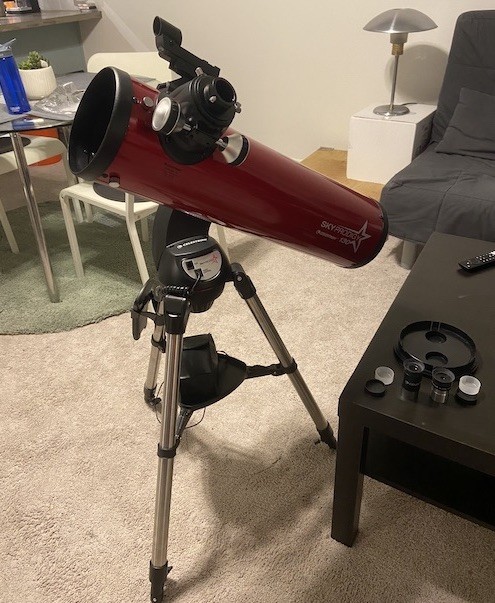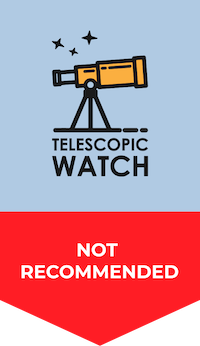At first glance, the Celestron SkyProdigy 130 OTA seemed to me like a rebadged NexStar 130SLT tube. Optically, it is still a 130mm f/5 Newtonian like the 130SLT, using more or less the same components.
My Experience With Its Focuser
The focuser on the SkyProdigy 130 is an all-plastic rack-and-pinion unit with a 2.5” drawtube with an included 1.25” adapter and (at least sometimes) a 2” adapter.
Despite being all plastic, I find that the focuser on the SkyProdigy works remarkably well. When testing mine with a laser, I found almost no drawtube wobble or collimation shift, though focusing at high power can be a little difficult due to the coarseness of the rack.
This being said, I wouldn’t recommend using 2” eyepieces with this telescope, as the focuser’s plastic build and lack of adjustable tension mean it will struggle under the weight of a large eyepiece, and the mount will be more prone to vibrations with an increasingly heavy payload placed on it.
My Opinion On the Accessories Provided
The SkyProdigy 130 comes with two metal-housed, 1.25” Kellner eyepieces: a 25mm (26x) and a 9mm (72x). I find these eyepieces surprisingly good, but I believe a telescope that costs more than $500 should really have Plossls. The included Kellners don’t even have rubber eyecups.
Despite the StarSense autoalign arguably eliminating the need for a finder, Celestron still supplies their StarPointer red dot sight. This is in case StarSense fails, which, as I’ll explain later, happens frequently. If it does fail, manual alignment can be done on bright stars using the same two-star or three-star alignment method as most GoTo telescopes.
The Problems That I Encountered With the SkyProdigy Mount
The SkyProdigy mount is very obviously heavily based on the Celestron’s own NexStar SLT mount’s components. In fact, I’d even conclude that it is more or less a NexStar SLT mount with red instead of orange trim and a StarSense hand controller and camera installed.
The tripod is still inadequate, especially with the legs extended to any length—the scope flexes and wobbles. However, I think this is less of a concern compared to the StarSense issues.
The StarSense hand controller comes with a 40,000 object database, so a lack of objects isn’t a concern here. But StarSense itself has a whole host of problems.
- For one, there’s the simple concern of power consumption.
The SkyProdigy 130 comes with a battery pack that takes eight AA batteries. A good computerized scope will run these down in a night or two, but the SkyProdigy has to slew itself around the entire sky multiple times every time it’s set up in order to figure out where it’s pointing and (hopefully) align itself. This means that it burns through the batteries quickly. Even if you purchase an aftermarket power supply, I suspect the SkyProdigy will run it down fast.
- More importantly, the SkyProdigy mount is unreliable.
Unlike the StarSense addon, which has been improved over the years, the SkyProdigy mounts still run on the same technology as when they came out in 2014. The mount frequently fails to align itself entirely, and sometimes it won’t let me do a manual alignment instead.
Furthermore, the mount’s camera is frequently misaligned with the telescope itself, causing inaccurate slewing even if alignment is “successful”. This is because, rather than attaching to the scope’s optical tube the way the StarSense addon does, the SkyProdigy’s StarSense camera is built into the mount. And since I can’t actually tell what the camera is seeing since the system is entirely self-contained, I have no way of knowing whether the whole system is properly lined up or not.
Users have reported 10, 15, or even 20-degree errors, and I have seen similar errors when using these scopes myself. I don’t get why Celestron didn’t opt to attach the camera to the tube or add a port to connect the camera to a display and check alignment, but I know for certain that the decision to do neither was a poor one.
If there was a large user base for the SkyProdigy scopes, I would not be as worried about the software and hardware issues, as there would probably be some official and third-party fixes out there for both. However, this is not the case, as next to no one owns the SkyProdigy telescopes compared to Celestron’s other products like the NexStars.
Alternative Recommendations
The SkyProdigy 130 is far from my first choice.
At the same price as the SkyProdigy 130, and even well below it, there are a lot of good alternatives that I’d recommend giving serious thought to.
Celestron itself has two 130mm computerized reflectors that are better than the SkyProdigy 130 in every way, and even those aren’t as good as some of the other options I’ve chosen for you here. Here are a few diverse instruments that we’ve selected for your consideration.
- The Apertura AD8‘s 8” mirror provides 2.5x the light-gathering ability of the SkyProdigy 130 along with 60% more resolving power. It’s aimed manually, so you don’t need to worry about motors, power, or software problems. The AD8’s easy-to-use Dobsonian mount takes seconds to set up and aim at a target of your choosing, and the scope includes a variety of high-quality features and accessories such as a 2” dual-speed Crayford focuser, 9×50 finder, and built-in cooling fan.
- The Sky-Watcher Virtuoso GTi 150P offers a larger aperture than the SkyProdigy 130, a steady tabletop Dobsonian mount, easy alignment and control via your smartphone, and the ability to be aimed manually—all in a low-priced GoTo package that collapses to fit even in luggage.
- The Celestron Astro Fi 130 features the same basic form factor, optics, and mechanics as the SkyProdigy 130 but replaces the auto-alignment upgrade with the ability to control and align the telescope on the sky using your smartphone or tablet and ditching the outdated, old-fashioned hand controller.
We’d also recommend you check out the Telescope Ranking page to choose a better scope.
Aftermarket Accessory Recommendations
If you’ve purchased or acquired a Celestron SkyProdigy 130 for whatever reason, there are some additional accessories I’d recommend to get the most out of your experience with it. Namely, an extra eyepiece: a 6mm Goldline eyepiece such as the one sold by SVBONY. This will provide 108x, a more suitable magnification for the Moon and planets than the mere 65x with the included 10mm.
Another useful item might be a power supply. There are a lot of options out there, but something like the TalentCell 600 mAh battery and a male-to-male power adapter to connect it is a good solution. You can attach it to the tripod legs with the fastener of your choice or let it rest on the tripod spreader.
Lastly, an inexpensive collimation tool such as the Astromania Cheshire might be a good idea and will make at least one part of the setup of the SkyProdigy 130 a little less painful.
What can you see with the Celestron SkyProdigy 130?
Within the solar system, the Celestron SkyProdigy 130 is capable of a lot, particularly if you add one or two extra high-magnification eyepieces.
- Mercury and Venus will show their phases.
- The Moon looks great (except, of course, when it’s near full and shows hardly any shadows or relief), and you can see details on it as small as a few miles across.
- Mars’ polar ice cap is easily visible, and when it’s close to Earth, you can just make out a few dark albedo features on its surface—along with, of course, any dust storms that encircle the planet.
- Jupiter’s cloud belts and Great Red Spot are easy, and its 4 largest moons (Io, Europa, Ganymede, and Callisto) are visible as tiny dots and silhouettes when they transit/eclipse the planet.
- Saturn’s rings and the gap within them known as the Cassini Division look fantastic. With some effort, you can also see Saturn’s cloud band structure and a few of its moons.
- Uranus and Neptune are nearly stellar dots, and their moons are too faint for the 130 to pick up.
The Celestron SkyProdigy 130 is also a great telescope for low-power deep-sky viewing.
Its wide field of view and decent aperture make it great for viewing open clusters such as M35, M11, and the Pleiades, or perhaps the Sagittarius Star Cloud.
The brighter nebulae, such as Orion, the Swan, and the Lagoon, similarly look excellent. With a good UHC or oxygen-III filter, you can spot the Veil Nebula. The Dumbbell Nebula looks great with or without a filter, while the Ring and a few other planetary nebulae are visible—albeit pretty small—with the SkyProdigy 130. And of course, the Blinking Planetary will do its trick for you.
Unfortunately, 5 inches of aperture is insufficient to reveal individual stars in globular clusters or detail in most galaxies. With some luck, you might be able to pick out the dust lanes in Andromeda and M82 and perhaps just barely see the brightest globulars, such as M13 and M3, as grainy smudges.
Astrophotography
The SkyProdigy 130’s mount is an alt-azimuth design, adequate for visual astronomy but not precise, stable, or useful enough for most astrophotography. You could hypothetically use it for planetary imaging with a good camera and a powerful Barlow lens, but there are better options at this price that will deliver better images with fewer compromises.




Hi Zane
It is sad that Celestron Skyprodigy 130 is not highly recommended by you. I bought this 3 years ago and still has yet to be able to align the tripod and the telescope. I had only tried 3 times and since then put aside till now to try again. But it looks like I will have the same issues as you commented.
This was my first purchase as I am a newbie to astronomy. I was told by the salesman that it is a computerised telescope and user friendly. That was not correct!
Can you suggest how I am able to align the tripod and the telescope? Is it rtue that it my tripod is not aligned in the centre, the telescope alignment will be out of whack?
Thanks
Richard
I would just put the telescope tube on a different mount.
Just bought the tripod and mount second-hand for my C5 but haven’t tried it yet. As bad as it is , hw d the mount and tripod cmpare with the original GT scopes, pre-2014. My C5 rode very well on a 114GT, fixed mount and wden legs. Has lots of fun with it.